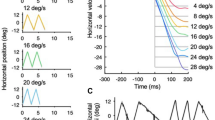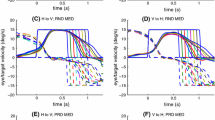Abstract
Anticipatory smooth eye movements precede expected changes in target motion. It has been questioned whether anticipatory smooth eye movements are a component of the smooth pursuit system. Five subjects with unilateral brain lesions and five control subjects were tested with predictable double-ramp stimuli to determine whether these lesions have a similar effect on horizontal, visually guided smooth pursuit, anticipatory smooth eye movements, and the predictive component of smooth pursuit. All four subjects with a brain lesion involving the parietal or parietal-frontal lobe had parallel velocity asymmetries in all three forms of smooth eye movements, with lowest velocities toward the side of the lesion. A similar uniformity and magnitude of smooth eye movement directional asymmetries were not found in control subjects. Unidirectional attenuation of these three forms of smooth eye movements provides evidence that they are part of a unified smooth eye movement system.
Similar content being viewed by others
References
Assad JA, Maunsell JHR (1995) Neuronal correlates of inferred motion in primate posterior parietal cortex. Nature 373:518–521
Becker W, Fuchs AF (1985) Prediction in the oculomotor systems: smooth pursuit during transient disappearance of a visual target. Exp Brain Res 57:562–575
Boman DK, Hotson JR (1988) Stimulus conditions that enhance anticipatory smooth eye movements. Vision Res 28:1157–1165
Boman DK, Hotson JR (1989) Motion perception prominence alters anticipatory smooth eye movements. Exp Brain Res 74:555–562
Boman DK, Hotson JR (1992) Predictive smooth pursuit eye movements near abrupt changes in motion direction. Vision Res 32:675–689
Damasio H, Damasio AR (1989) Lesion analysis in neuropsychology. Oxford University Press, New York, pp 141–221
Fox PT, Fox JM, Raichle ME, Burde RM (1985) The role of cerebral cortex in the generation of voluntary saccades: a positron emission tomography study. J Neurophysiol 54:348–369
Gottlieb JP, MacAvoy MG, Bruce CJ (1994) Neural responses related to smooth pursuit eye movements and their correspondence with electrically elicited smooth eye movements in the primate frontal eye field. J Neurophysiol 72:1634–1653
Kao GW, Morrow MJ (1994) The relationship of anticipatory smooth eye movement to smooth pursuit initiation. Vision Res 34:3027–3036
Keating EG (1993) Lesions of the frontal eye field impair pursuit eye movements, but preserve the predictions driving them. Behav Brain Res 53:91–104
Komatsu H, Wurtz RH (1989) Modulation of pursuit eye movements by stimulation of cortical areas MT and MST. J Neurophysiol 62:31–47
Kowler E, Steinman RM (1979a) The effect of expectations on slow oculomotor control. I. Periodic target steps. Vision Res 19:619–632
Kowler E, Steinman RM (1979b) The effect of expectations on slow oculomotor control. II. Single target displacements. Vision Res 19:633–646
Morris EJ, Lisberger SG (1987) Different responses to small visual errors during initiation and maintenance of smooth-pursuit eye movements in monkeys. J Neurophysiol 58:1351–1369
Morrow MJ, Sharpe JA (1990) Cerebral hemispheric localization of smooth pursuit asymmetry. Neurology 40:284–292
Morrow MJ, Sharpe JA (1995) Deficits of smooth-pursuit eye movements after unilateral frontal lobe lesions. Ann Neurol 37:443–451
Newsome WT, Wurtz RH, Komatsu H (1988) Relation of cortical areas MT and MST to pursuit eye movements. II. Differentiation of retinal from extraretinal inputs. J Neurophysiol 60:604–620
Thurston SE, Leigh JR, Crawford T, Thompson A, Kennard C (1988) Two distinct deficits of visual tracking caused by unilateral lesions of cerebral cortex in humans. Ann Neurol 23:266–273
Author information
Authors and Affiliations
Rights and permissions
About this article
Cite this article
Braun, D.I., Boman, D.K. & Hotson, J.R. Anticipatory smooth eye movements and predictive pursuit after unilateral lesions in human brain. Exp Brain Res 110, 111–116 (1996). https://doi.org/10.1007/BF00241380
Received:
Accepted:
Issue Date:
DOI: https://doi.org/10.1007/BF00241380




